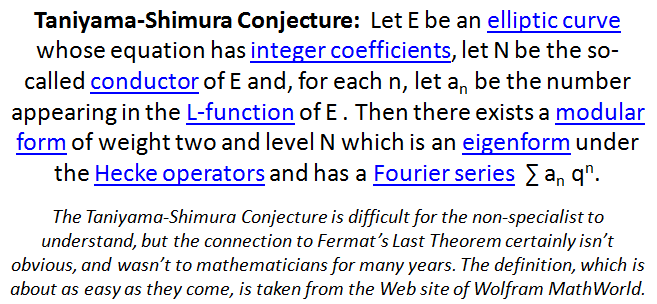Yutaka Taniyama and the Tanımama-Shimura Conjecture
by Andrew Boyd
Today, a tragic ending. The University of Houston's College of Engineering presents this series about the machines that make our civilization run, and the people whose ingenuity created them.
Mathematician Andrew Wiles made history in 1995 when he proved Fermat's Last Theorem. It had puzzled mathematicians for three and a half centuries. And its solution made headlines.

Wiles rightly deserves credit for his achievement. But the story isn't as simple as a single mathematician locking himself in a room with pencil and paper.
The final push to the finish line began forty years before Wiles' proof. At a conference in Tokyo, a young mathematician named Yutaka Taniyama made a conjecture. It was special because it connected two very different areas of mathematics: topology — the study of shapes, and number theory — which deals with whole numbers. He refined the idea with friend and collaborator Goro Shimura.

The Taniyama-Shimura Conjecture was remarkable in its own right. But it gained special notoriety when, after thirty years, mathematicians made a connection with Fermat's Last Theorem. Specifically, if the conjecture could be shown true, then it would also prove Fermat's Last Theorem.
It's worth pausing at this point. Mathematicians had shown that a historic problem about whole numbers could be reduced to a question about shapes. The Taniyama-Shimura Conjecture was a long way from the problem Fermat had loosed upon the world. But it gave mathematicians an entirely new way of looking at things.
And the new perspective proved bountiful. Within ten years of discovering the connection, Andrew Wiles brought Fermat's longstanding question to its knees.
Taniyama and Shimura's names will forever be linked with Fermat's Last Theorem. But there's a sad coda to the story. Taniyama never lived to see the impact of his work. Three years after he put forward his conjecture, he took his life. And no one really understands why. Even Taniyama seemed unsure. "I don't understand it myself," he wrote in his final note, "but it is not the result of a particular incident I've [merely] lost confidence in my future."
More perplexing is that Taniyama was busy making plans for what appeared to be a bright and happy future. His early publications were well received. He was planning to marry, and had gone so far as to sign a lease on an apartment with his fianc', Misako Suzuki. Taniyama's death took a horrible toll on the young woman. She was so distraught that a month later she took her own life. But unlike her spouse to be, Suzuki was clear in purpose. She explained to the world in her final note. "We promised each other that no matter where we went, we would never be separated," she wrote. "Now that he is gone, I must go to join him."
I'm Andy Boyd at the University of Houston, where we're interested in the way inventive minds work.
Notes and references:
For related episodes, see FERMAT'S LAST STAND and LAME, CAUCHY, AND KUMMER.
Wiles proved a restricted form of the Taniyama-Shimura Conjecture sufficient for proving Fermat's Last Theorem. The complete Taniyama-Shimura Conjecture was proved in its entirety in 2001 and is sometimes referred to as the Modularity Theorem.
Modularity Theorem. From the Wikipedia Web site: https://en.wikipedia.org/wiki/Modularity_theorem. Accessed May 3, 2011.
Taniyama-Shimura Conjecture. From the Wolfram MathWorld Web site: http://mathworld.wolfram.com/Taniyama-ShimuraConjecture.html. Accessed May 3, 2011.
Thanks to listener Bill Spindler for suggesting the topic of this essay.
All pictures by E. A. Boyd.